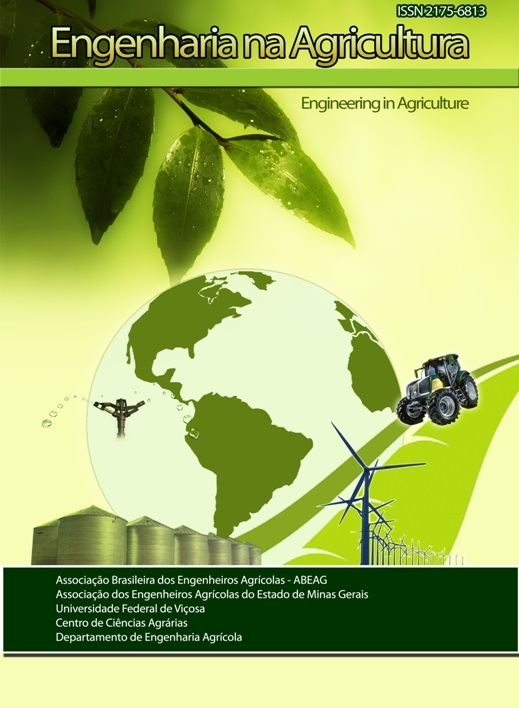GREEN WATER FOOTPRINT AND SUSTAINABILITY FOR ESPIRITO SANTO STATE
DOI:
https://doi.org/10.13083/reveng.v28i.970Keywords:
fresh water, actual evapotranspiration, water scarcityAbstract
Water footprint is a relatively new concept of freshwater appropriation that considers its direct and indirect use by a consumer or producer and used as a comprehensive indicator of the appropriation of water resources. The objective of this study was to estimate the green water footprint and evaluate its sustainability in the state of Espírito Santo, using the land use information and indicators of water scarcity. The total green water footprint was estimated by the sum of the green water footprints of pasture, forest, coffee cultivation, forestry, and other agricultural uses. The state’s total green footprint estimated was 47.5 billion m³/year, and the pasture class represented 48.5% of this total, followed by forest (29.8%), coffee cultivation (10.1%), forestry (6.4%), and other crops (5.2%). The ratio between the mean annual total volume of precipitated water and the green WF in the state was 80%. The environmental sustainability assessment shows that the green footprint was unsustainable for most of the year, on average, mainly in the May to September.
Downloads
References
ALLEN, R.G.; PEREIRA, L.S.; RAES, D.; SMITH, M. Crop evapotranspiration: Guidelines for computing crop water requirements. FAO Irrigation and Drainage. Paper 56, p.300, 1998.
ALVARES, C.A.; STAPE, J.L.; SENTELHAS, P.C.; GONÇALVES, J.L.M.; SPAROVEK, G. Köppen’s climate classification map for Brazil. Meteorologische Zeitschrift, v.22, n.6, p.711-728, 2013.
ALVES, M.E.B.; MANTOVANI, E.C.; SEDIYAMA, G.C.; NEVES, J.C.L. Estimate of the crop coefficient for Eucalyptus cultivated under irrigation during initial growth. Cerne, v.19, n.2, p.247-253, 2013.
BLENINGER, T.; KOTSUKA, L.K. Conceitos de água virtual e pegada hídrica: estudo de caso da soja e óleo de soja no Brasil. Revista Recursos Hídricos, v.36, n.1, p.15-24, 2015.
CASTRO, F.S.; PEZZOPANE, J.R.M.; CECÍLIO, R.A.; PEZZOPANE, J.E.M. Uso de imagens de radar na espacialização da temperatura do ar. Idesia (Arica), v.28, n.3, p.69-79, 2010.
CECÍLIO, R.A.; SILVA, K.R.; XAVIER, A.C.; PEZZOPANE, J.R.M. Método para a espacialização dos elementos do balanço hídrico climatológico. Pesquisa Agropecuária Brasileira, v.47, n.4, p.478-488, 2012.
EMPINOTTI, V.L.; JACOBI, P.R. Novas práticas de governança da água? O uso da pegada hídrica e a transformação das relações entre o setor privado, organizações ambientais e agências internacionais de desenvolvimento. Desenvolvimento e Meio Ambiente, v.27, p.23-36, 2013.
HARGREAVES, G.H.; SAMANI, Z.A. Reference crop evapotranspiration from temperature. Applied Engineering in Agriculture, v.1, n.2, p.96-99, 1985.
HOEKSTRA, A.Y.; CHAPAGAIN, A.K.; ALDAYA, M.M.; MEKONNEN, M.M. The water footprint assessment manual: Setting the global standard, Londres: Earthscan. 2011. 191p.
LEAL, A.P.P.N.; CECÍLIO, R.A.; ZANETTI, S.S. Pegada hídrica para a bacia hidrográfica do rio Itapemirim. Scientia Agricola, v.19, n.2, p.100-113, 2018.
LIU, J.; ZEHNDER, A.J.B.; YANG, H. Global consumptive water use for crop production: The importance of green water and virtual water. Water Resources Research, v.45, n.5, p.1-15, 2009.
MEKONNEN, M.M.; HOEKSTRA, A.Y. National water footprint accounts: the green, blue and grey water footprint of production and consumption, Value of Water Research Report Series No. 50, UNESCO-IHE, Delft, the Netherlands. 2011a. 44p.
MEKONNEN, M.M.; HOEKSTRA, A.Y. The green, blue and grey water footprint of crops and derived crop products. Hydrology and Earth System Sciences, v.15, n.5, p.1577-1600, 2011b.
MIRANDA, F.R.; RENATA, A.; GOMES, M.; HENRIQUE, C.; OLIVEIRA, C. Evapotranspiração e coeficientes de cultivo do coqueiro anão-verde na região litorânea do Ceará. Revista Ciência Agronômica. v.38, n.2, p.129-135, 2007.
PEREIRA, A.R.; ANGELOCCI, L.R.; SENTELHAS, P.C. Agrometeorologia: Fundamentos e Aplicações Práticas. Lavras: Agropecuária, 2002. 478p.
SCHYNS, J.F.; HOEKSTRA, A.Y.; BOOIJ, M.J. Review and classification of indicators of green water availability and scarcity. Hydrology and Earth System Sciences, v.19, n.11, p.4581-4608, 2015.
SILVA, K.R.; CECÍLIO, R.A.; XAVIER, A.C.; PEZZOPANE, J.R.M.; GARCIA, G.O. Interpolação espacial da precipitação no Estado do Espírito Santo. Floresta e Ambiente, v.18, n.4, p.417-427, 2011.
SILVA, V.P.R.; ALEIXO, D.O.; DANTAS NETO, J.; MARACAJÁ, K.F.B.; ARAÚJO, L.E. Uma medida de sustentabilidade ambiental: pegada hídrica. Revista Brasileira de Engenharia Agrícola e Ambiental, v.17, n.1, p.100-105, 2013.
THORNTHWAITE, C.W.; MATHER, J.R. The water balance. Centerton, NJ: Drexel Institute of Technology – Laboratory of Climatology, 1955. 104p. (Publications in Climatology, vol. VIII, n.1).
VANHAM, D.; BIDOGLIO, G. A review on the indicator water footprint for the EU28. Ecological Indicators, v.26, n.2013, p.61-75, 2013.
XAVIER, A.C.; KING, C.W.; SCANLON, B.R. Daily gridded meteorological variables in Brazil (1980-2013). International Journal of Climatology, v.36, n.6, p.2644-2659, 2016.
ZANETTI, S.S.; DOHLER, R.E.; CECÍLIO, R.A.; PEZZOPANE, J.E.M.; XAVIER, A.C. Proposal for the use of daily thermal amplitude for the calibration of the Hargreaves-Samani equation. Journal of Hydrology, v.571, p.193-201, 2019.
Downloads
Published
How to Cite
Issue
Section
License
Copyright (c) 2020 REVISTA ENGENHARIA NA AGRICULTURA - REVENG

This work is licensed under a Creative Commons Attribution-NonCommercial 4.0 International License.
Authors who publish with this journal agree to the following terms:
The author(s) authorize(s) the publication of the text in the journal;
The author(s) ensure(s) that the contribution is original and unpublished and that it is not in the process of evaluation by another journal;
The journal is not responsible for the views, ideas and concepts presented in articles, and these are the sole responsibility of the author(s);
The publishers reserve the right to make textual adjustments and adapt texts to meet with publication standards.
From submission, the author is fully conceding the paper's patrimonial rights to the publication, but retaining the owner of its moral rights (authorship and paper's identification) according to Creative Commons Attribution-Noncommercial.








 Licensed by
Licensed by 